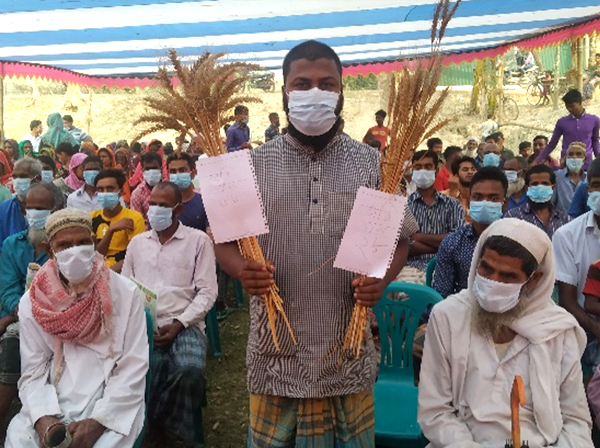Farmer field days (FFDs) are on-farm classrooms which help farmers learn successful farming technologies and techniques, and get practical information from agricultural experts, fellow farmers and research organizations that the farmers can use to plan or enhance their own operations.
Farmer field days also help farmers see how farming techniques can be practically used and applied to improve yields and economic returns, as well as nutrition security and economic growth in a broader economic sense.
Staple crop biofortification is a cost-effective and sustainable way to improve vitamin and mineral intake in people’s diets. As part of our efforts to bring biofortified crops to farming, and focus on long-term and sustained uptake, farmer field days remain an integral part of activities in India, Pakistan, and Bangladesh. It is one of the main reasons why uptake and scaling of biofortified crops in these countries is rising rapidly.
Engaging farmers in India
As part of the Bihar-Odisha Nutrition Initiative (BONI), in 2021, over 24 field days were conducted across Bihar for zinc wheat and five for zinc rice; and seven field days were conducted in Uttar Pradesh for zinc wheat. The type of events included: Demo seed distribution programs, awareness programs on zinc wheat, exposure visits to zinc wheat plots and local farmer-to-farmer interaction with successful farmers. These events not only help create awareness among new growers, they also create demand for growing and consuming biofortified foods and develop new collaborations, thereby advancing biofortified crops.1
Overall, 10,067 participants attended and benefitted from these events focusing on zinc wheat. In 2021, 816,277 farming households in India were growing zinc wheat.
HarvestPlus works with more than 100 partners across India. These include research entities, non-governmental organization (NGO) partners—the majority of whom play an important role in reaching farmers—and private-sector partners in the seed, food processing, and retail sectors.
Around 29 field and awareness days on iron pearl millet were conducted during 2021, across Maharashtra, Rajasthan, Karnataka and Uttar Pradesh.
Overall, 2481 participants attended and benefitted from these events focusing on iron pearl millet.
Among those who addressed the farmers were scientists from Krishi Vigyan Kendras (KVK) or the local agriculture extension centres; officials from the state agriculture department, partner university representatives, subject matter experts from NGOs, seed specialists from the private seed sector, successful progressive farmers, and staff of HarvestPlus India.
Farmer field days and events empower farmers and community members through information on where to acquire improved seeds. This creates increased market opportunities and enhances farmer-to-farmer exchanges of improved seeds.
Our experience has shown that farmer field events have a positive impact on reaching farmers—our primary stakeholders—and explaining to them the impact of nutrition at the seed level. Conducting large farmer outreach programs is easier with proper planning and preparation, which requires intensive involvement of both the facilitators and stakeholders.
Saroj Devi, East Champaran, Bihar, India
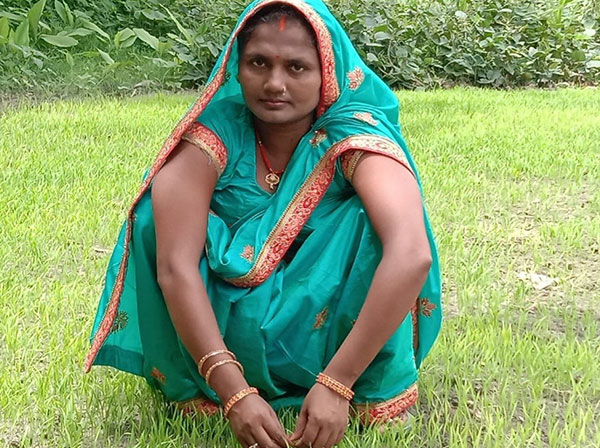
Saroj Devi, is one such farmer who attended a farmer field day and seed distribution program last year. She is now an enthusiastic zinc wheat farmer from East Champaran district in Bihar.
A woman farmer in her 30s, she hails from Koiri Tola village, Bairia block, West Champaran, Bihar. She started growing biofortified zinc wheat in 2020. She was introduced to zinc wheat in one of the farmer meetings conducted in the village last year, and she was happy to adopt. Planting about 18kg of zinc wheat seed gave her a harvest of a little over 600kg of wheat grain.
She grew regular wheat varieties until now. However, with a bounty of harvest from last year, she is now an ardent fan of biofortified zinc wheat.
“With this wheat variety flour, you don’t have to work hard on the dough. The rotis (Indian flat bread) are very soft and easy to make. My father-in-law is particularly very happy and has expressed a desire to continue growing only biofortified zinc wheat from now on. In addition to the grain quality, the plants also grow well in tough geographical conditions. We are happy we tried growing this variety, and now there is no looking back.”
Saroj Devi continues to grow biofortified zinc wheat on her land this year too. The harvest this year has increased by around 160kg per acre. She is one of the many happy women farmers from East Champaran in Bihar.
Ram Vinay Kumar, Kukribigah Village, Bihar
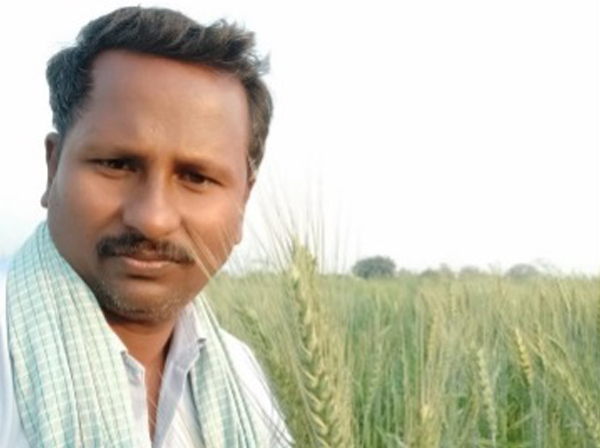
Ram Vinay Kumar is a farmer from Kukribigah village, Bihar and has been growing zinc wheat for three years now on 5 acres of land. The average harvest from his field is between 200-225Kg every year. He has held demonstrations in his field for other farmers and has inspired many of them to take up farming of biofortified wheat.
“Having grown regular wheat varieties in the past, I find growing zinc wheat much more profitable and healthier. The growth and yield are of superior quality. The wheat panicle size is good, and the plant height is medium. The grain of BHU-25 is round and beautiful, and the grain size of BHU-31 is long and slender. I will continue to grow zinc wheat and I am thankful to HarvestPlus for introducing these varieties to us. I have shared my experiences with fellow farmers by bringing them to my field and sharing my story during farm events. A lot of them have been inspired and now grow zinc wheat in their fields.”
Sensitizing farmers in Pakistan
Wheat is the major staple crop and main source of energy for the Pakistani population. The level of per capita consumption is among the highest in the world.
With the objective to eliminate hidden hunger among the most malnourished populations, HarvestPlus is working with a wide variety of stakeholders from the public and private sectors in Pakistan to popularize biofortified zinc wheat varieties. FFDs are among the important outreach activities which help raise awareness about malnutrition and train farmers on growing biofortified zinc wheat varieties.
These outreach activities provide an opportunity to interact with farmers, share experiences, address their questions and provide technical assistance on crop management, such as the use of fertilizers and disease control. The FFDs help farmers learn how they can play an important role in achieving nutrition security and ultimately contributing to reduced stunting rates, and improved physical growth and brain development of our children. The farmers also learn to apply various farming techniques which help them to increase yield, thereby better supporting their families through increased earnings and profitability, which ultimately helps enhance their families’ livelihoods.
With the support and collaboration of HarvestPlus, Pakistan National and Provincial Wheat Programs have released three Zinc wheat varieties so far, namely, Zincol-2016, Akbar 2019 and Nawab 2021. These varieties are disease resistant, have high yield and high grain zinc. Farmers like these characteristics, which are major motivating factors for them to grow biofortified zinc wheat varieties.
In Pakistan, more than 36,000 metric tons of certified zinc wheat seed was planted during the crop season of 2021-22. In addition, farmers also planted biofortified zinc wheat seed which they kept from the last harvest or received from fellow farmers. It is estimated that more than 3.5 million metric tons of wheat grain will be harvested in the ongoing harvesting season of wheat crop. In 2021, more than 1.4 million farming households were growing zinc wheat in Pakistan.
The FFDs are proven to be effective in promoting the zinc wheat seed varieties. These activities have not only helped in increasing the cultivated area of biofortified zinc wheat varieties through farmers who attended these FFDs, but also helped increase awareness about malnutrition through fellow farmers.
“We organized 17 FFDs during 2021 across the province of Punjab,” said Yaqub Mujahid, Country Manager of HarvestPlus Pakistan. He said that more than 3000 farmers benefited from these FFDs. “The participation of women farmers also remained significant in these FFDs. More than 200 women farmers also attended and learned about various traits and competitive advantages of biofortified zinc wheat varieties” he added.
Rana Muhammad Khan, General Secretary, Farmers Association of Faisalabad
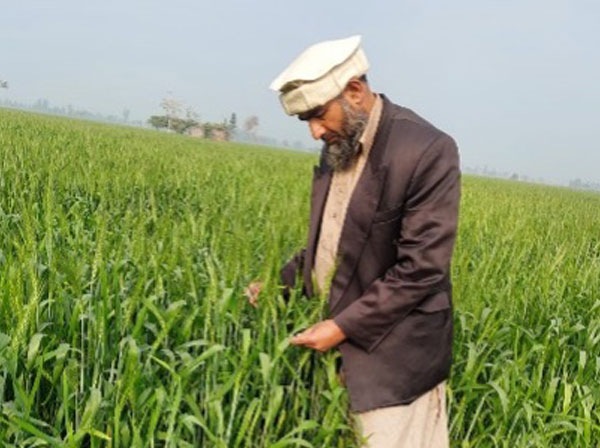
“I wasn’t aware that the malnutrition situation is so grave in the country, and is particularly prevalent among farming families, until I attended a field farm day at Amin Pur Bungalow Faisalabad, organized by HarvestPlus Pakistan. During the event, the farmers were sensitized to understand zinc deficiency and its health and economic consequences.”
We learned that we can protect our families and communities from zinc deficiency by growing biofortified zinc wheat varieties and consuming food made from it. The FFD provided us the opportunity to interact with agricultural scientists. It raised our confidence in growing biofortified wheat varieties. This year, I have planted 5 acres of Akbar 2019, a biofortified zinc wheat variety and my crop is growing well so far. I am applying the learnings from FFD and by looking at my crop, I am hoping to have better yield this year. Next year I am planning to increase the cultivation area for Akbar 2019.
Hafiz Muhammad Tariq, Progressive Wheat Grower, Village Shehbazpur, Sadiqabad Rahim Yar Khan
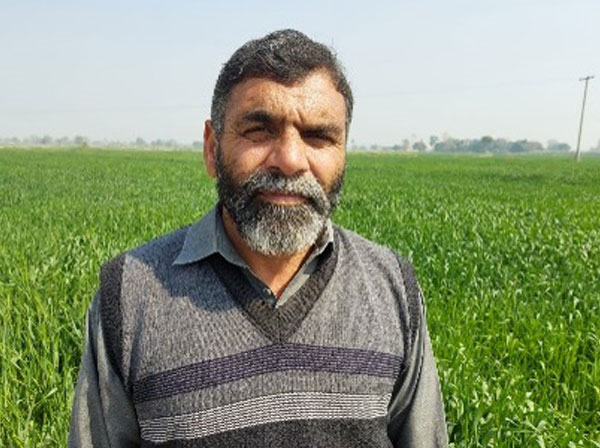
“I am regularly cultivating Zinc wheat varieties on my farms. Last year we cultivated Akbar 2019 on 10 acres and Zincol 2016 on 5 acres. We were introduced to these varieties through a farmer field day held at Rahim Yar Khan. The reason for growing these varieties, is better yield, more profitability and better zinc nutrition for our families. Since my family has started using zinc wheat, we have felt that our health is improving. I am also asking my neighbors to consume bread prepared from zinc wheat.”
Popularizing biofortified zinc wheat in Bangladesh
As an effective method to create awareness and disseminate agriculture technologies regarding biofortified crops, HarvestPlus Bangladesh organized six farmers’ field days, in 2021, on demonstration plots of zinc wheat variety, BARI Gom-33, with the objectives of creating awareness among the participants on the importance of zinc for human health and showcasing the performance of zinc wheat in farmer’s plots.
A total of 1,080 participants including 699 men and 381 women participated in these field days. Several personnel from Department of Agriculture, NGOs, and representative of local government institutions attended the activities. They highlighted the field performance of biofortified zinc wheat varieties, crop-cut results, cost-benefit analysis, and how to scale-up zinc wheat cultivation and improve the nutritional status of Bangladeshis. The demo farmers also shared their field experience with the participants. Most of the participants were able to gather knowledge on zinc wheat varieties and their nutritional benefits, which made them confident about adopting these varieties.
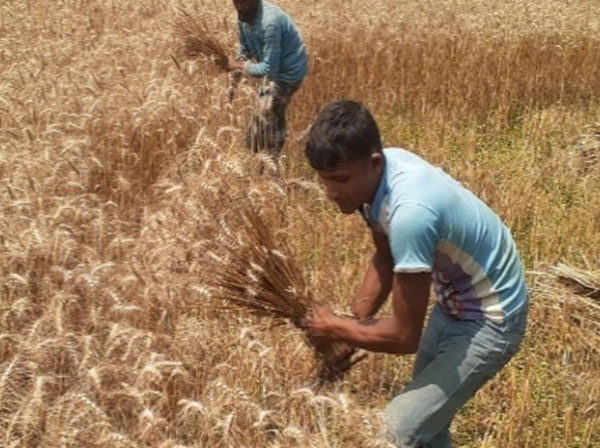
In addition, participating 300 farmers harvested their zinc wheat plots and they were happy to see the performance of the wheat variety BARI Gom-33. The average yield of 48 demonstration plots of BARI Gom-33 was reported as 3.67 MT per hectare. Besides seed, fertilizer, and signboards support, these 64 demonstrations farmers were also provided with airtight seed storage containers to preserve quality seed for further multiplication. All these farmers will be consuming a portion of their produce, which will contribute to food and nutrition security at the community level during the COVID-19 pandemic.
Amzad Ali, a local farmer said, “This zinc-enriched variety has more spike length2 and more grain per spike, and almost twice the yield as compared to other non-biofortified varieties. It also experiences relatively low incidence of insect infestation and disease. It also tastes better!”
- These events were conducted in Sagarpur, Bajitpur, Tetriya, Patna, Pusa, Chintamanpur, Sawangia, Bhagalpur, Ara, Chabilapur, Rajgir, Hasanpur, Kobba, Wajir Ganj, Bikramganj and Chandoli, Samastipur, Buxar, Kaimur, Kukribagh, Nalanda, Vaishali, Gaya, Rampura Muzaffarpur of Bihar state and Badhya, Bilari, villages (Azamgarh district), Dubauli (Gorakpur district), Hamirpur locations and Prayagraj (Bahadurpur), Mau (Ratanpura), Bahraich (Kesarganj), Shrawasti (Sirsiya), Ambedkar Nagar (Ram Nagar), Lakhimpur Kheri (Lakhimpur), Pratapgarh (Magraura Patti), Basti (Harraiya), Chitarkoot (Karvi) in Uttar Pradesh State with farmer participation from many neighboring villages.
- The spike (also called the ear or head) forms at the top of the plant. A spike usually has 35-50 grains (or kernels).
